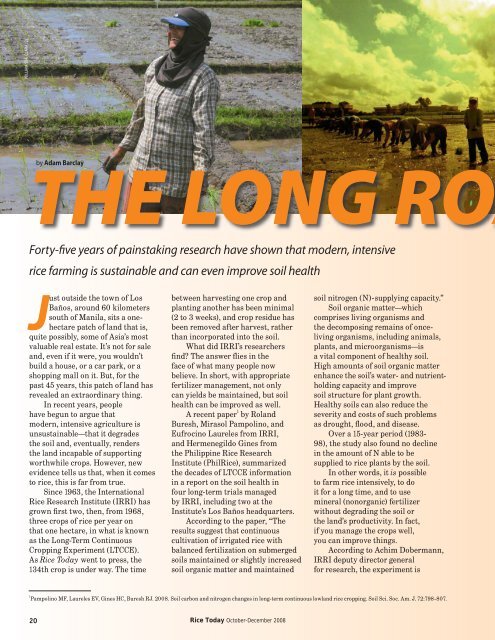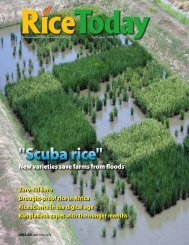Rice Today - adron.sr
Rice Today - adron.sr
Rice Today - adron.sr
You also want an ePaper? Increase the reach of your titles
YUMPU automatically turns print PDFs into web optimized ePapers that Google loves.
WILLIAM STA. CLARA (2)THEby Adam BarclayLONG ROAForty-five years of painstaking research have shown that modern, intensiverice farming is sustainable and can even improve soil healthJust outside the town of LosBaños, around 60 kilometerssouth of Manila, sits a onehectarepatch of land that is,quite possibly, some of Asia’s mostvaluable real estate. It’s not for saleand, even if it were, you wouldn’tbuild a house, or a car park, or ashopping mall on it. But, for thepast 45 years, this patch of land ha<strong>sr</strong>evealed an extraordinary thing.In recent years, peoplehave begun to argue thatmodern, intensive agriculture isunsustainable—that it degradesthe soil and, eventually, rendersthe land incapable of supportingworthwhile crops. However, newevidence tells us that, when it comesto rice, this is far from true.Since 1963, the International<strong>Rice</strong> Research Institute (IRRI) hasgrown first two, then, from 1968,three crops of rice per year onthat one hectare, in what is knownas the Long-Term ContinuousCropping Experiment (LTCCE).As <strong>Rice</strong> <strong>Today</strong> went to press, the134th crop is under way. The timebetween harvesting one crop andplanting another has been minimal(2 to 3 weeks), and crop residue hasbeen removed after harvest, ratherthan incorporated into the soil.What did IRRI’s researchersfind? The answer flies in theface of what many people nowbelieve. In short, with appropriatefertilizer management, not onlycan yields be maintained, but soilhealth can be improved as well.A recent paper 1 by RolandBuresh, Mirasol Pampolino, andEufrocino Laureles from IRRI,and Hermenegildo Gines fromthe Philippine <strong>Rice</strong> ResearchInstitute (Phil<strong>Rice</strong>), summarizedthe decades of LTCCE informationin a report on the soil health infour long-term trials managedby IRRI, including two at theInstitute’s Los Baños headquarters.According to the paper, “Theresults suggest that continuouscultivation of irrigated rice withbalanced fertilization on submergedsoils maintained or slightly increasedsoil organic matter and maintainedsoil nitrogen (N)-supplying capacity.”Soil organic matter—whichcomprises living organisms andthe decomposing remains of oncelivingorganisms, including animals,plants, and microorganisms—isa vital component of healthy soil.High amounts of soil organic matterenhance the soil’s water- and nutrientholdingcapacity and improvesoil structure for plant growth.Healthy soils can also reduce theseverity and costs of such problemsas drought, flood, and disease.Over a 15-year period (1983-98), the study also found no declinein the amount of N able to besupplied to rice plants by the soil.In other words, it is possibleto farm rice intensively, to doit for a long time, and to usemineral (nonorganic) fertilizerwithout degrading the soil orthe land’s productivity. In fact,if you manage the crops well,you can improve things.According to Achim Dobermann,IRRI deputy director generalfor research, the experiment is1Pampolino MF, Laureles EV, Gines HC, Buresh RJ. 2008. Soil carbon and nitrogen changes in long-term continuous lowland rice cropping. Soil Sci. Soc. Am. J. 72:798-807.20 <strong>Rice</strong> <strong>Today</strong> October-December 2008RT7-4 (p1-23)_FA.indd 2010/9/2008 8:24:43 AM
















